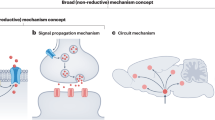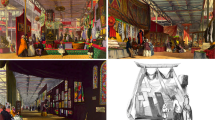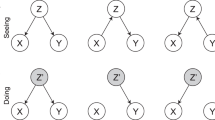Abstract
Causal reductionism is the widespread assumption that there is no room for additional causes once we have accounted for all elementary mechanisms within a system. Due to its intuitive appeal, causal reductionism is prevalent in neuroscience: once all neurons have been caused to fire or not to fire, it seems that causally there is nothing left to be accounted for. Here, we argue that these reductionist intuitions are based on an implicit, unexamined notion of causation that conflates causation with prediction. By means of a simple model organism, we demonstrate that causal reductionism cannot provide a complete and coherent account of ‘what caused what’. To that end, we outline an explicit, operational approach to analyzing causal structures.
This is a preview of subscription content, access via your institution
Access options
Access Nature and 54 other Nature Portfolio journals
Get Nature+, our best-value online-access subscription
$29.99 / 30 days
cancel any time
Subscribe to this journal
Receive 12 print issues and online access
$209.00 per year
only $17.42 per issue
Buy this article
- Purchase on Springer Link
- Instant access to full article PDF
Prices may be subject to local taxes which are calculated during checkout



Similar content being viewed by others
Code availability
The code used for the simulations can be accessed freely at https://github.com/wmayner/pyphi/blob/develop/pyphi/examples.py/.
References
Marr, D. Vision: a Computational Investigation into the Human Representation and Processing of Visual Information (MIT Press, 1982).
Krakauer, J. W., Ghazanfar, A. A., Gomez-Marin, A., MacIver, M. A. & Poeppel, D. Neuroscience needs behavior: correcting a reductionist bias. Neuron 93, 480–490 (2017).
Bickle, J. Marr and reductionism. Top. Cogn. Sci. 7, 299–311 (2015).
Kim, J. Mind in a Physical World: an Essay on the Mind–Body Problem and Mental Causation (MIT press, 1998). Classical philosophical work introducing the causal exclusion argument and employing it in the context of reductive physicalism.
Crick, F. The Astonishing Hypothesis (Scribner’s, New York, 1994). An explicit endorsement of causal reductionism in the neuroscience literature. Strictly speaking, Crick was making an ontological statement in addition to a causal statement.
Albantakis, L. & Tononi, G. The intrinsic cause–effect power of discrete dynamical systems—from elementary cellular automata to adapting animats. Entropy 17, 5472–5502 (2015).
Albantakis, L., Marshall, W., Hoel, E. & Tononi, G. What caused what? a quantitative account of actual causation using dynamical causal networks. Entropy 21, 459 (2019). Formal exposition of causal structure analysis, which is based on an interventional, counterfactual notion of causation. Rather than testing a single counterfactual, causal structure analysis takes into account all possible counterfactuals (system states), allowing for a probabilistic formulation. Further differences with other approaches to actual causation are also discussed, including the distinction between cause and effect, composition, integration and exclusion.
Juel, B. E., Comolatti, R., Tononi, G. & Albantakis, L. When is an action caused from within? Quantifying the causal chain leading to actions in simulated agents. in Proceedings of the ALIFE 2019: The 2019 Conference on Artificial Life, 477–484 (MIT Press, 2019).
Lettvin, J. Y., Maturana, H. R., McCulloch, W. S. & Pitts, W. H. What the frog’s eye tells the frog’s brain. Proc. IRE 47, 1940–1951 (1959).
Albantakis, L., Hintze, A., Koch, C., Adami, C. & Tononi, G. Evolution of integrated causal structures in animats exposed to environments of increasing complexity. PLoS Comput. Biol. 10, e1003966 (2014).
Albantakis, L. & Tononi, G. Causal composition: structural differences among dynamically equivalent systems. Entropy 21, 989 (2019).
Oizumi, M., Albantakis, L. & Tononi, G. From the phenomenology to the mechanisms of consciousness: Integrated Information Theory 3.0. PLoS Comput. Biol. 10, e1003588 (2014).
Tononi, G., Boly, M., Massimini, M. & Koch, C. Integrated information theory: from consciousness to its physical substrate. Nat. Rev. Neurosci. 17, 450–461 (2016). The IIT formalism establishes whether a system qualifies as an intrinsic entity—a maximum of intrinsic, structured, specific, irreducible cause–effect power—which is required for a complete account of causation, since only what exists can cause. The IIT analysis of cause–effect power examines potential causes and effects from the intrinsic perspective of a system in a single state (potential causation). By contrast, causal structure analysis examines what actually caused what based on a sequence of states that have happened (actual causation). It should be noted that in this paper we do not consider whether our example systems qualify as intrinsic entities and what that would imply for causation. Instead, we have attempted to illustrate the incoherence of causal reductionism purely within a biological and functional framework.
Haun, A. & Tononi, G. Why does space feel the way it does? Towards a principled account of spatial experience. Entropy 21, 1160 (2019).
Ay, N. & Polani, D. Information flows in causal networks. Adv. Complex Syst. 11, 17–41 (2008).
Janzing, D., Balduzzi, D., Grosse-Wentrup, M. & Schölkopf, B. Quantifying causal influences. Ann. Stat. 41, 2324–2358 (2013).
Halpern, J. Y. & Pearl, J. Causes and explanations: a structural-model approach. Part I: causes. Br. J. Philos. Sci. 56, 843–887 (2005). Halpern and Pearl’s account is currently the most established approach to actual causation. Unlike causal structure analysis, it does not evaluate causal strength. Instead, it aims to provide a set of contingency conditions under which a simple, counterfactual test may be applied to identify variables that are causally relevant for the occurrence of a particular event.
Halpern, J. Y. Actual Causality (MIT Press, 2016).
Pearl, J. Causality: Models, Reasoning and Inference (Cambridge University Press, 2000). Seminal contribution introducing a causal calculus—a formal framework to evaluate interventions in causal Bayesian networks. The book also offers an overview over methods for ‘causal inference’—how to define a causal model from sparse data. While causal structure analysis makes use of interventions and causal Bayesian networks, it is not concerned with causal inference.
Gomez, J. D., Mayner, W. G. P., Beheler-Amass, M., Tononi, G. & Albantakis, L. Computing Integrated Information (Φ) in discrete dynamical systems with multi-valued elements. Entropy 23, 6 (2020).
Putnam, H. Psychological Predicates. in Art, Mind and Religion (eds. W. Capitan & D. Merrill) 37–48 (University of Pittsburgh Press, 1967).
Sober, E. The multiple realizability argument against reductionism. Philos. Sci. 66, 542–564 (1999).
Aizawa, K. Neuroscience and multiple realization: a reply to Bechtel and Mundale. Synthese 167, 493–510 (2009).
Aizawa, K. Multiple realizability by compensatory differences. Eur. J. Philos. Sci. 3, 69–86 (2013).
Tononi, G., Sporns, O. & Edelman, G. M. Measures of degeneracy and redundancy in biological networks. Proc. Natl Acad. Sci. USA 96, 3257–3262 (1999).
Kelso, J. S. Multistability and metastability: understanding dynamic coordination in the brain. Philos. Trans. R. Soc. B Biol. Sci. 367, 906–918 (2012).
Brennan, C. & Proekt, A. A quantitative model of conserved macroscopic dynamics predicts future motor commands. Elife 8, e46814 (2019).
Hemberger, M., Pammer, L. & Laurent, G. Comparative approaches to cortical microcircuits. Curr. Opin. Neurobiol. 41, 24–30 (2016).
Marder, E., Goeritz, M. L. & Otopalik, A. G. Robust circuit rhythms in small circuits arise from variable circuit components and mechanisms. Curr. Opin. Neurobiol. 31, 156–163 (2015).
McIntosh, A. R. Contexts and catalysts. Neuroinformatics 2, 175–181 (2004).
Pouget, A., Dayan, P. & Zemel, R. Information processing with population codes. Nat. Rev. Neurosci. 1, 125–132 (2000).
Haxby, J. V. et al. Distributed and overlapping representations of faces and objects in ventral temporal cortex. Science 293, 2425–2430 (2001).
Haxby, J. V., Connolly, A. C. & Guntupalli, J. S. Decoding neural representational spaces using multivariate pattern analysis. Annu. Rev. Neurosci. 37, 435–456 (2014).
Panzeri, S., Macke, J. H., Gross, J. & Kayser, C. Neural population coding: combining insights from microscopic and mass signals. Trends Cogn. Sci. 19, 162–172 (2015).
Frégnac, Y. Big data and the industrialization of neuroscience: a safe roadmap for understanding the brain? Science 358, 470–477 (2017).
Deco, G., Jirsa, V. K., Robinson, P. A., Breakspear, M. & Friston, K. The dynamic brain: from spiking neurons to neural masses and cortical fields. PLoS Comput. Biol. 4, e1000092 (2008).
Beer, R. D. Beyond control: the dynamics of brain–body–environment interaction in motor systems. Adv. Exp. Med. Biol. 629, 7–24 (2009).
Norton, J. D. Causation as folk science. Philosophers’ Imprint 3, 1–22 (2003).
Hume, D. An Enquiry Concerning Human Understanding (Clarendon Press, 2000). 1748.
Russell, B. On the notion of cause. Proc. Aristotelian Soc. 13, 1–26 (1913).
Lewis, D. K. On the Plurality of Worlds. (Blackwell, 1986).
Chicharro, D. & Ledberg, A. When two become one: the limits of causality analysis of brain dynamics. PLoS ONE 7, e32466 (2012).
James, R. G., Barnett, N. & Crutchfield, J. P. Information flows? a critique of transfer entropies. Phys. Rev. Lett. 116, 238701 (2016).
Selimbeyoglu, A. & Parvizi, J. Electrical stimulation of the human brain: perceptual and behavioral phenomena reported in the old and new literature. Front. Hum. Neurosci. 4, 46 (2010).
Zhang, S. et al. Selective attention. Long-range and local circuits for top-down modulation of visual cortex processing. Science 345, 660–665 (2014).
Massimini, M., et al. Breakdown of cortical effective connectivity during sleep. Science 309, 2228–2232 (2005).
Friston, K. J., Harrison, L. & Penny, W. Dynamic causal modelling. Neuroimage 19, 1273–1302 (2003).
Valdes-Sosa, P. A., Roebroeck, A., Daunizeau, J. & Friston, K. Effective connectivity: influence, causality and biophysical modeling. Neuroimage 58, 339–361 (2011).
Davidson, D. Mental events. In Readings in Philosophy of Psychology (ed. Block, N.) 107–119 (Cambridge, Harvard University Press, 1980).
Kim, J. Physicalism, or Something Near Enough (Princeton University Press, 2005).
Kim, J. Supervenience and supervenient causation. South. J. Philos. 22, 45–56 (1983).
Kelso, J. A. Synergies: atoms of brain and behavior. Adv. Exp. Med. Biol. 629, 83–91 (2009).
Hoel, E. P., Albantakis, L., Marshall, W. & Tononi, G. Can the macro beat the micro? Integrated information across spatiotemporal scales. Neurosci. Conscious. 1, niw012 (2016).
Marshall, W., Albantakis, L. & Tononi, G. Black-boxing and cause-effect power. PLoS Comput. Biol. 14, e1006114 (2018).
Albantakis, L., Massari, F., Beheler-Amass, M. & Tononi, G. A macro agent and its actions. Preprint at https://arxiv.org/abs/2004.00058 (2020).
Acknowledgements
We thank M. Boly, A. Cattani, F. Ellia, G. Findlay, B. Juel, W. Marshall, W. Mayner, G. Mindt and R. Verhagen, and especially J. Hendren, for their comments on the manuscript. This project was made possible through support from Templeton World Charity Foundation (nos. TWCF0216 and TWCF0526) and by The Tiny Blue Dot Foundation (UW 133AAG3451). The opinions expressed in this publication are those of the authors and do not necessarily reflect the views of Templeton World Charity Foundation and The Tiny Blue Dot Foundation.
Author information
Authors and Affiliations
Corresponding author
Ethics declarations
Competing interests
The authors declare no competing interests.
Additional information
Peer review information Nature Neuroscience thanks Viktor Jirsa and Klaas Stephan for their contribution to the peer review of this work.
Publisher’s note Springer Nature remains neutral with regard to jurisdictional claims in published maps and institutional affiliations.
Supplementary information
Supplementary Information
Supplementary Notes 1 and 2 and Supplementary Figs. A1 and B1–B3
Rights and permissions
About this article
Cite this article
Grasso, M., Albantakis, L., Lang, J.P. et al. Causal reductionism and causal structures. Nat Neurosci 24, 1348–1355 (2021). https://doi.org/10.1038/s41593-021-00911-8
Received:
Accepted:
Published:
Issue Date:
DOI: https://doi.org/10.1038/s41593-021-00911-8
This article is cited by
-
Integrated Information is not Causation: Why Integrated Information Theory’s Causal Structures do not Beat Causal Reductionism
Philosophia (2023)
-
The transcendental deduction of Integrated Information Theory: connecting the axioms, postulates, and identity through categories
Synthese (2022)
-
Emergentist Integrated Information Theory
Erkenntnis (2022)



